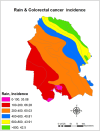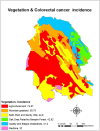Geographical Distribution of Colorectal Cancer in Southwestern Iran Between Years 2011 and 2019
- PMID: 37681264
- PMCID: PMC10645291
- DOI: 10.5152/tjg.2023.22666
Geographical Distribution of Colorectal Cancer in Southwestern Iran Between Years 2011 and 2019
Abstract
Background/aims: Colorectal cancer is one of the most common cancers in the world. Various genetic, individual, and environmental factors are associated with this disease. Today, the role of environmental and geographical factors has been considered. Accordingly, the present study was conducted to determine the cumulative incidence and geographical distribution of colorectal cancer in Khuzestan province.
Materials and methods: This study was performed ecologically to determine the cumulative incidence of colorectal cancer and its geographical distribution in Khuzestan province between 2011 and 2019. The required information was extracted from the cancer registration program of the Ministry of Health and after refinement and replication.
Results: The cumulative incidence of colorectal cancer in Khuzestan province between 2011 and 2019 was estimated at 40.18 per 100 000 people. The highest cumulative incidence was related to Ahvaz city (95.87 per 100 000 people) and the lowest was related to DashtAzadegan city (25.35 per 100 000 people). The highest cumulative incidence of colorectal cancer, based on climate conditions, is in dry geographical areas (63.77 per 100 000 people), based on average annual rainfall, is in areas with an average rainfall of 100-200 mm (66.28 per 100 000 people), and based on land use, belonged to areas with agricultural use (74.57 per 100 000 people).
Conclusion: The cumulative incidence of colorectal cancer is relatively high in Khuzestan province. The cumulative incidence of the disease was higher in the central regions of the province than in other regions. Also, based on geographical areas, the cumulative incidence of the disease was higher in areas with arid climates, the average rainfall was 100-200 mm, and in areas with agricultural land use.
Conflict of interest statement
Figures







References
-
- Goodarzi E, Beiranvand R, Naemi H, Momenabadi V, Khazaei Z. Worldwide incidence and mortality of colorectal cancer and human development index (HDI): an ecological study. World Cancer Res J. 2019;6:8.
MeSH terms
LinkOut - more resources
Full Text Sources
Medical
